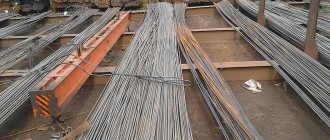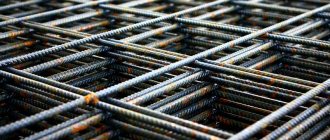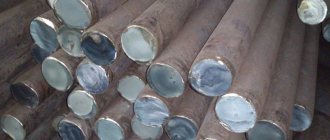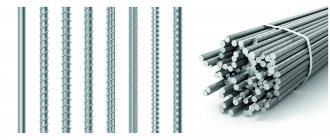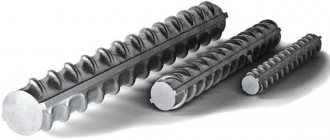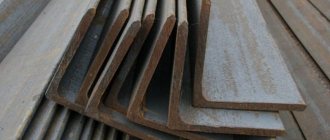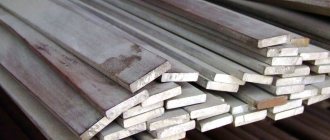Types of fittings
Reinforcement is a rolled metal product. Depending on its purpose, conditions of use and type of steel, it is divided into six classes. One of them is A3 (A400) fittings. There are two types of reinforcement profiles: smooth (constant cross-section) and corrugated (ribbed).
The smooth profile is mainly produced according to individual orders. Corrugated reinforcement A3 has two longitudinal ribs, which are made at equal intervals at the same angle to the longitudinal line of the rod, and two transverse protrusions. Thanks to the periodic profile, better adhesion of the reinforcing bar to the concrete is ensured.
Performance characteristics and application
The main features of this rolled metal product include the following:
- Strength of adhesion to concrete. It is achieved due to the corrugated surface of the rods. It has long been known that corrugated reinforcement holds artificial stone much better and does not peel off from it even under the influence of very high loads. In this it is much superior to products with a smooth profile.
- The reliability of the rods themselves. These products are made from durable steel grades. Accordingly, it does not collapse under loads and lasts for many years.
- Flexibility to create objects of non-standard shapes. In addition, the plasticity of the rods ensures that their integrity is maintained during vibrations. For example, during an earthquake, A3 will not break under the influence of vibration. After the end of the deforming effect, the reinforcement will return to its original form and maintain the integrity of the entire structure.
- Rust resistant. This reinforcement contains manganese. It prevents the development of corrosion and makes it possible to use A3 in difficult climatic conditions.
- Weather resistant. With a sharp change in temperature conditions, the metal frame retains its structure and ensures the integrity of the concrete it holds (artificial stone does not crack or crumble).
- Affordable prices. The low cost of products and their versatility make this type of rolled metal the most popular in many areas of application. It is not even being replaced by modern types of fittings that have more advantageous performance characteristics.
- Ease of processing. A3 products can be welded to produce durable frames of complex shapes. In addition to welding, specialists also practice connecting rods using binding wire.
Production methods
A3 reinforcement is manufactured by hot rolling. If the products are additionally hardened by heat treatment, the result is thermally strengthened reinforcement, designated At. When cold, reinforcing bars can be strengthened by drawing. Such rods are used for the production of prestressed reinforced concrete structures. The letter C is added to the name of the fittings suitable for welding; the letter K is resistant to corrosion cracks.
Scope of use
Due to its resistance to constant and short-term loads, vibrations, rust and temperature changes, this type of fittings is used for:
- Construction of buildings in difficult climatic zones. A3 is suitable for the construction of any civil and industrial facilities.
- Construction of large bridges.
- Placing metal structures in damp soil.
- Construction of road surfaces.
- Construction of tunnels, subways, underground communications and many other works.
We have the best price offers for A3 corrugated fittings . You will understand this yourself when you discuss the cost of purchased products with the employees of our company.
Diameter
A3 reinforcement can have the following rod diameters: from 6 mm to 40 mm. In this case, products from 6 mm to 10 mm are produced in coils, which are then unwound and cut into pieces 6 meters long, or in the form of rods. With a diameter of 12 mm and above, reinforcement is produced only in the form of rods 12 m long. In the construction of buildings and structures, A3 reinforcement 12 mm, 14 mm, 18 mm is most often used. As mentioned above, reinforcement products are produced in coils or in the form of rods.
The marking of various reinforcing bars must include their diameter, reinforcement class and GOST number according to which they are manufactured. For example, 10-A-3 GOST 5781-82 - this is how an A3 reinforcement rod with a diameter of 10 mm is designated.
A500S and B500S fittings according to GOST R 52544-2006
And the last regulatory document that we will focus on is GOST R 52544-2006. It is valid only on the territory of the Russian Federation. Determines production standards for rolled products of classes A500C and B500C. Why is this regulatory act important to us? It's simple. It states that reinforcing steel can be produced not only using hot rolling. Please note that index B has appeared. This means that B500C is cold-deformed and mechanically strengthened reinforcing metal. The index C means that it is welded. We hope you understand that 500 is the yield strength in N/mm². Moreover, despite the index A, A500C reinforcement can also be thermomechanically strengthened.
The main direction of use is usual - reinforcement of reinforced concrete structures. This type of metal products is produced in coils and rods (rods). Nominal diameter from 4.00 to 40.00 mm (A500C from 6.00 to 40.00 mm, B500C from 4.00 to 12.00 mm). Products with a diameter of up to 6.00 mm are produced in coils, and in coils and rods from 6.00 to 12.00 mm. Above 14.00 mm all rolled products are in rods. Their length is from 6.00 to 12.00 meters, regardless of manufacturing technology. Please note that the profile shape of both cold-deformed and hot-rolled steel is different.
This is where we will end our review. We hope that it has now become clear for this type of product such as A3 reinforcement, which type of long products it is. Read our blog. Now we have considered the question: “What is A3 fittings?” In subsequent materials we will talk about areas of application, features of choice, advantages and disadvantages.
Do you need A3 fittings? You can always buy it from our company, on favorable terms, with full documentary support. We'll help you make the right choice. Contact us!
A3 fittings: weight
In most cases, the amount of material required is calculated in linear meters. But for delivery to the work site, a weight calculation is often required, and you also need to know what volume the A3 reinforcement has. Weight is calculated based on the diameter of the product.
| Diameter, mm | Quantity m in 1t | Area, sq. cm | Weight 1 m, t |
| Rod d=6 | 4 504,50 | 0,283 | 0,000222 |
| Rod d=8 | 2 531,65 | 0,503 | 0,000395 |
| Rod d=10 | 1 620,75 | 0,785 | 0,000617 |
| Rod d=12 | 1 126,13 | 1,131 | 0,000888 |
| Rod d=14 | 826,45 | 1,540 | 0,001210 |
| Rod d=16 | 632,91 | 2,010 | 0,001580 |
| Rod d=18 | 500,00 | 2,540 | 0,002000 |
| Rod d=20 | 404,86 | 3,140 | 0,002470 |
| Rod d=22 | 335,57 | 3,800 | 0,002980 |
| Rod d=25 | 259,74 | 4,910 | 0,003850 |
| Rod d=28 | 207,04 | 6,160 | 0,004830 |
| Rod d=32 | 158,48 | 8,040 | 0,006310 |
| Rod d=36 | 125,16 | 10,180 | 0,007990 |
| Rod d=40 | 101,32 | 12,570 | 0,009870 |
How does A3 differ from A400
Quite often, people who need A3 fittings for a small construction project also come across the A400 marking. This is very confusing - despite exactly the same characteristics, appearance, composition and cost, the rods have different markings. In fact, there is no reason to worry - these are the same building material. It’s just that the A3 marking is classic, and the A400 began to be used relatively recently. So, when you come to the store to choose products, you can pick up products with any marking - you definitely won’t have to regret the bad choice later.
In addition, problems may arise when identifying S400 fittings - this is the same class of fittings, but only according to a different classification. Therefore, the scope of application is no different, as are other important technical characteristics.
Technical requirements
For the production of class A3 fittings, carbon or low-alloy steel grades 35GS or 25G2S are used. In terms of chemical composition, carbon steel must comply with GOST 380. When producing low-alloy steel, the presence of carbon is necessary: 35GS - from 0.3% to 0.37%, 25G2S - from 0.2% to 0.29% and manganese: 35GS - from 0 .8% to 1.2%, 25G2S – from 1.2% to 1.6%. In addition, the composition of the 35GS brand also includes sulfur - 0.045% and phosphorus - 0.04%. In addition, the addition of titanium during manufacturing is allowed: from 0.01% to 0.06%.
Mechanical characteristics of class A3 fittings:
- The yield strength is not less than 40 kgf/sq.m. mm.
- Temporary tensile strength is not less than 60 kgf/sq.m. mm.
- Relative elongation – 14%.
On the entire surface of the reinforcing bar, including protrusions and ribs, cracks, ruptures, rolling sunsets and caps are not allowed.
The main differences between A3 and A500C
Among the classes of reinforcement, the type of rolled metal closest to A3 is A500C. These are thermally strengthened products, the production of which is carried out using the hot-rolled or cold-formed method. When producing these rods, microalloying is also used. Reinforcement of this class is made of ST3PS - structural carbon steel.
Due to thermal hardening, this product contains a minimum of alloying elements (when compared with their amount in the A3 composition). A small amount of alloying components makes it possible to produce a high-quality frame for objects using manual arc welding (after welding, there are no defects or vulnerable spots that are susceptible to loads).
The A500C reinforcement, created using the corrugated method, has transverse protrusions in the shape of sickles and two longitudinal ribs. The transverse and longitudinal protrusions do not intersect with each other. This property increases the strength of the reinforcement, because under heavy load, stress will not concentrate at the intersection of crescent-shaped protrusions and longitudinal ribs.
According to approved state standards, the carbon content in raw materials should not exceed 0.5%. In the case of class A500C, the reinforcement is manufactured from steel containing no more than 0.22% carbon. In addition, the production of this class requires much less raw materials than A3 reinforcement (in the manufacture of rods, steel is consumed approximately 20% more economically). This allows you to reduce the weight of the frame and significantly reduce the cost of its production.
The A500C production technology guarantees greater durability of structures and facilitates working with them due to easy weldability (such advantages are achieved due to the low carbon content in raw materials and heat treatment of the finished product). Such favorable characteristics make A500C fittings in demand in many fields of activity.
Having examined the main characteristics of the A500C, one should summarize all the differences between this product and the A3 and make sure that the class identity is erroneous. So, the most important differences between these classes:
- Weldability index. Rolled metal of type A3 was developed in the 50s of the 20th century. Then carbon steel was proposed for its manufacture. The percentage composition of carbon in this raw material reached 0.37%. Such a high carbon content did not allow welding work to be carried out easily, namely, the use of manual arc welding. When using this method, the rods were welded together, but the structure itself turned out to be very unstable to loads. Accordingly, it could collapse at any moment. This is a serious threat when it comes to tunnels, bridges, subways or multi-story buildings. Therefore, reinforcement with A3 should be accompanied by careful control of the work performed. If you replace A3 with A500C metal, it will be possible to carry out manual arc welding due to the low carbon content in the reinforcement.
- Yield limit. For class A3 products it is 400 N/sq. mm, and for A500C products this figure reaches 500 N/sq. mm. A higher yield strength coefficient can reduce production costs and significantly reduce the weight of the finished structure.
- Differences in the corrugated surface of products. The A500C reinforcement has crescent-shaped protrusions on the surface of the rods, while the A3 has transverse protrusions in the shape of rings. Rods of both classes are equipped with two longitudinal ribs located opposite each other. But for A3 rolled metal, the rings are in contact with the longitudinal protrusions, and for A500C products, the crescent-shaped notch does not intersect the side ribs. Consequently, A500C can rightfully be considered a more durable product that can easily withstand heavy loads. After all, the intersection of longitudinal and transverse protrusions entails an increase in stress concentration at the points of contact of the notch, instead of distributing it over the entire surface of the reinforcement.
- Protrusion pitch indicator. If we compare both classes, then the A500C has a much smaller distance between the transverse protrusions than the A3 with the same diameter. This feature of rolled metal indicates a good level of adhesion of its surface to concrete. After all, the more notches on the rod, the better it is fixed in the artificial stone, gives the structure strength and protects the monolith from cracking under the influence of thermal, mechanical or vibration loads.
Application area
The fittings are used for civil construction of buildings and structures, industrial construction. A3 reinforcement is the most common and popular class, especially for use in massive and heavy structures. Scope of use:
- Construction of metal structures.
- For reinforcing concrete products.
- Strengthening floors and walls of buildings and structures.
- Reinforcement of reinforced concrete products.
Such products are used for reinforcing concrete in order to give it additional rigidity, as well as for the production of various welded metal structures: grilles for windows and doors, metal fences, reinforcing mesh. The use of reinforcing bars extends the operational life of buildings. The strength and durability of the structures being built depends on the quality of the reinforcement used. A3 has good technical indicators, such as strength, elasticity of steel, and its weldability. A3 reinforcement is also used for monolithic concreting.
Rods of size d=10 mm are used as the main reinforcement when used in low-rise construction, and as clamps for beams and crossbars in high-rise construction. A3 with a diameter of 12 mm is used in main load-bearing structures, foundations and monolithic walls. Due to its larger diameter, it has a smaller laying step - 20 cm. For the foundation, rods of at least 10 mm in size are used. The larger the diameter of the reinforcing bars, the stronger the foundation frame.
Classes of fittings and areas of their use
On sale you will find rods that vary in diameter, length and surface type.
There are smooth and grooved varieties. For ease of designation, they were divided into classes, each with an area of use and a set of characteristics, as well as the steel grade of the reinforcement. There are the following types:
- A1 (A240, AI). One of the most common types of materials for the manufacture of reinforced concrete products is trays, floor slabs, and support elements. The diameter ranges from 6 to 40 mm. Depending on this parameter, the product is supplied in skeins or rods.
- A2 (A300, AII). The diameter reaches 80 mm. Can be used as a frame for piles. Installation in concrete increases its resistance to vertical loads.
- A3 (A 400, A III ). There are ribs on the surface of the rod. Corrugation improves adhesion to concrete. Diameter up to 40 mm. Products up to 10 mm are supplied in skeins, larger quantities in rods.
- A4 (A600, AIV). Metal elements are used as the basis for reinforced concrete products for various purposes. They are suitable for the production of parts subject to dynamic loads. It is also widely used in construction – not only civil, but also industrial.
- A5 (A800, AV). The material is created from structural low-alloy steel. The recommended area of application is the creation of prestressed concrete products. Suitable for the construction of bridges and hydraulic structures.
- A6 (A1000, AVI). The characteristics allow the use of steel rods in the most critical areas - from nuclear industry facilities to dams. Since the product is expensive, it is produced upon pre-order. Provides good adhesion to concrete due to the special structure of the ribs - they are ring-shaped or crescent-shaped. Can also be used with reinforced concrete products. Reinforcement significantly extends their service life.
- A400C . Manufactured using the hot-rolled method. The diameter reaches 40 mm. It is distinguished by the presence of two ribs located longitudinally. Used in private construction, in the construction of low structures.
- A500C . Additionally strengthened by mechanical and thermal methods. Not adapted to strong dynamic loads, used with basic types of reinforced concrete products.
- A600C . It is characterized by increased resistance to corrosion due to the addition of molybdenum and vanadium to the alloy. Suitable for monolithic houses, construction in areas with high seismic activity.
Below is a table of classes and brands of fittings with the main characteristics listed.
| Reinforcement class | Rolled diameter | steel grade | Mechanical properties, no less | |||
| σT, N/mm2 yield strength | σB, N/mm2 tensile strength | σS, % relates elongation | Cold bending test, C – mandrel diameter, B – rod diameter | |||
| A-I (A 240) | 6-40 | St3kp, St3ps, St3sp | 235 | 373 | 25 | 180 deg C=d |
| A-II (A 300) | 10-40 | St5sp, St5ps | 295 | 490 | 19 | 180 deg C=3d |
| 40-80 | 18G2S | |||||
| AC-II (AC 300) | 10-32 | 10GT | 295 | 441 | 25 | 180 deg C=d |
| A-III (A 400) | 6-40 | 35GS, 25G2S | 390 | 590 | 14 | 90 deg C=3d |
| 6-22 | 32G2Rps | |||||
| A-IV (A 600) | 10-18 | 80C | 590 | 883 | 6 | 45 degrees C=5d |
| 10-32 | 20ХГ2Ц, 20ХГ2Т | |||||
| А-V (А 800) | 10-32 | 23Х2Г2Т, 23Х2Г2Ц | 785 | 1030 | 7 | 45 degrees C=5d |
| A-VI (A1000) | 10-22 | 22Kh2G2AYu, 22Kh2G2R, 20Kh2G2SR | 980 | 1230 | 6 | 45 degrees C=5d |
Determination by eye
Any reinforced building structure, one way or another, consists of reinforcement. In order not to get confused in the types of structures and their frames, it is advisable to be able to distinguish the rods by eye, at least their main characteristics.
Example of smooth reinforcement class A1
This skill will help you in the future. Moreover, it is not so difficult to develop it. Construction reinforcement is very different from industrial reinforcement, and rods of the first classes, with their difference in profile, are completely recognizable without any difficulty.
All that is required of you is to remember a few rules, and then follow them every time you are required to recognize what kind of products lie under your feet.
First of all, we look at the profile of the rod. A smooth profile is always the first, less often the second class. Products of the third and higher classes with a smooth profile are not produced at all. Accordingly, the corrugated profile is evidence that this is reinforcement of class A3 or higher.
Next we look at the diameter, weight and length. Samples of class A3 and A4 have similar diameters, but the latter, as a rule, is larger and made of higher quality steel.
Industrial products of classes A5 and A6 are easier to identify when you have already seen them. But in general terms it can be described as enlarged rolled steel products, with a large length and an enlarged crescent or ring profile.
By learning these simple rules, you will learn to distinguish one class from another, without the need for documentation. Everything else will come with experience.
Steel grades for the production of fittings
The grade classification and classes of reinforcing steel indicate the performance characteristics. Among the most common varieties:
- 20GS . Structural low alloy steel. It lends itself well to welding, therefore it is suitable for the manufacture of reinforcing frames.
- 35GS . Another structural low-alloy variety. Well protected from aggressive environments and pressure.
- St3kp . Structural carbon of ordinary quality. Shows good adhesion to concrete and does not deteriorate due to pressure, vibration, or exposure to aggressive environments.
- 22Х2Г2АУ . The characteristics of this low-alloy structural steel make it suitable for use in both conventional and prestressed concrete structures.
- 80C . Durable material that can withstand high stress and aggressive environmental influences.
The table below shows the correspondence of the class of reinforcing steel, the grade of raw materials used in the manufacture and the profile diameter of the created rod.
Table of reinforcement classes and steel grades - steel for reinforcement according to GOST 5781-82
| Profile type | Class | Diameter, mm | steel grade |
| Smooth profile | A1 (A240) | 6-40 | St3kp, St3ps, St3sp |
| Periodic profile | A2 (A300) | 10-40, 40-80 | St5sp, St5ps, 18G2S |
| Periodic profile | A3 (A400) | 6-40, 6-22 | 35GS, 25G2S, 32G2Rps |
| Periodic profile | A4 (A600) | 10-18 (6-8), 10-32 (36-40) | 80С, 20ХГ2Ц |
| Periodic profile | A5 (A800) | 10-32 (6-8), (36-40) | 23Х2Г2Т |
| Periodic profile | A6 (A1000) | 10-22 | 22Х2Г2АУ, 22Х2Г2Р |
What determines the scope of application of fittings?
Several factors influence where a particular type of rod will be used:
- Degree of workload.
- Potential threats.
- Scope of application of reinforced concrete products or location of the reinforced building.
Before you buy a batch of steel rods, you need to understand what the loads acting on them will be - static or dynamic. The mechanical parameters of the future frame are also taken into account. If you need to connect several parts by welding, the steel must have a good level of weldability.
A3 fittings: GOST standards
A3 reinforcement is produced in accordance with GOST 5781-82 “Hot-rolled steel for reinforcement of reinforced concrete structures”. Since the quality of the resulting product depends on the source raw material, and the strength and reliability characteristics of future buildings and structures depend on it, GOST imposes strict requirements on steel, which is used for the manufacture of reinforcement products. At3 reinforcement is produced in accordance with GOST 10884-94 “Thermomechanically strengthened reinforcing steel for reinforced concrete structures.” It replaced the previously valid GOST 10884-81 “Reinforcement rod steel thermomechanically and thermally strengthened with periodic profile.”
Material advantages
The high prevalence of A3 fittings is primarily due to its excellent performance properties, among which the following are especially worth noting:
- Long term of use without loss of its qualities;
- Immunity to biological and chemical influences;
- High strength values, both tensile and compressive, as well as external mechanical load;
- Excellent anti-corrosion properties;
- Excellent weldability;
- High-quality adhesion to the concrete mass, as well as low expansion of the material in this environment;
- Safety.
